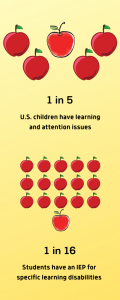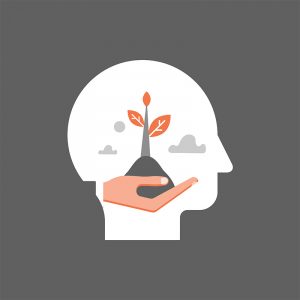Thinking on Education: Reaching and Empowering Students with Learning Disabilities

Data courtesy the National Center for Learning Disabilities
1 in 5 children in the United States have learning and attention issues, and only 17% of teachers say they “feel very well prepared to teach” these students.
This disparity was highlighted earlier this year in a joint report, “Forward Together,” by the National Center for Learning Disabilities and Understood.org. The report further explained that most teachers want and need training about teaching strategies to help students with learning disabilities.
The 1 in 5 includes students who struggle with developmental disabilities, specific learning disabilities (SLD) — such as dyslexia — and other health impairments (OHI). OHI is the disability category that covers attention deficit hyperactivity disorder (ADHD) and motor skills delays.
While very few states have specific coursework that trains general education teachers in teaching strategies to help those with disabilities, there is a variety of literature that shares evidence-based ideas. These strategies not only help the 1 in 5, but every student.
Start with Inclusivity
Every single student comes to the classroom with their own strengths and weaknesses, regardless of whether they have a learning disability or not. Thus, teachers must start with an inclusive classroom.
The classroom should be a place of belonging, Michael Dunlea explained in his Sept. 4, 2019 Edutopia article. But “belonging” does not mean “fitting in.” It is not fitting into the mold of what we think is the perfect student, or fitting into specific behaviors that do not allow for cultural and learning differences.
“[S]tudents’ individuality and uniqueness should always be valued. Belonging in the classroom means ensuring that all students feel welcomed, comfortable, and part of the school family,” he added.
As we value and celebrate our students’ uniqueness, we also must recognize that they are not problems to be solved, but individuals with the capacity to learn, grow and change.
“Students don’t need to be fixed. They need teachers who make data-informed instructional decisions to match best practices to students’ needs. They need teachers who offer high support while holding them to high expectations by implementing appropriate scaffolds and rolling them back as the students demonstrate greater proficiency. And they need teachers who acknowledge their mistakes and engage in ongoing professional learning,” said Charles Alexander in a Sept. 17, 2019 Edutopia article.
Instill a Growth Mindset
 When teachers approach the classroom with a growth mindset, they believe in the learning potential of all students. They also believe in their own ability to adapt and change and improve. The growth mindset harnesses “the power of yet,” which allows for experimentation and learning from mistakes.
When teachers approach the classroom with a growth mindset, they believe in the learning potential of all students. They also believe in their own ability to adapt and change and improve. The growth mindset harnesses “the power of yet,” which allows for experimentation and learning from mistakes.
As the authors of “Forward Together” explain, this mindset helps both teachers and students see “how persistence, hard work, self-regulation, and effort relate to learning and other outcomes at school or work.”
Teach and Support Self-Advocacy
According to a 2018 report the National Center for Learning Disabilities (NCLD), teachers need to model and support self-advocacy skills for all their students, but especially those with learning disabilities. These skills include communicating their learning strengths and needs. Self-advocacy is an important part of student-directed learning.
Alexander shared a time when he learned from his own students, two English language learners, how to help them advocate on their own behalf. He explained that he had two Latina girls in his 8th grade English class who seemed to constantly talk during instruction.
When he confronted them about it, the girls were brave enough to tell him that they were translating “everything that was said in class into Spanish in order to comprehend it, and then formulate their responses.” One of the girls drafted her papers first in Spanish, to express herself correctly, then translated them into English to hand in.
“I was amazed and astonished by their grit and ingenuity,” he said. “I realized that instead of discouraging conversations between these two students, I needed to create opportunities for them to engage in discourse so that they could check their understanding.”
He changed his entire instructional approach to give all his students more opportunities to learn together. He encouraged them to interrupt him during instruction if they needed clarification.
Use Responsive Teaching
Alexander’s experience shows an example of responsive teaching that allows students to implement personalized learning.
According to the 2018 NCLD report, “Properly implemented, personalized learning has the potential to transform education. But this requires careful preparation of teachers in how they support students and grant choices in their learning. It requires that educators see their role as learning facilitators who are acutely aware of each student’s strengths, interests and challenges. And it calls for more ways to define and recognize those students’ success.”
To help students personalize their learning, Nina Parrish encouraged educators to regularly teach study skills. All students, she said in her April 27, 2018 Edutopia article, need to learn how to learn — how to take notes, read for information, research for a project or review for a test.
Matthew Lynch, in his July 7, 2016 EdWeek article, gave eight practical teaching strategies educators can implement today to specifically help students with learning disabilities:
1. During a test, allow students to block distractions with earplugs.
2. Use a large-print version of a test or novel.
3. Make use of assistive technology.
4. Use graphic organizers to present information.
5. Repeat written instructions aloud.
6. Allow students to take parts of a test separately.
7. Break down parts of a project into smaller assignments.
8. Use teacher notes and outlines of lectures, sequential information, visuals, and alternative exam formats.
Utilize Positive Behavior Strategies
Students with learning disabilities are often the most disruptive students in a class. To help them learn to self-regulate, teachers should instill positive behavior strategies into their classroom management.
When teacher’s instruction includes reflection, questions and problem-solving, students develop self-awareness, self-management and relationship skills. These skills help them better understand and express their own needs, while respecting others’.
“Instead of being a punitive system, positive behavior strategies help students learn to replace a challenging or disruptive behavior with one that is more effective in addressing their needs. Teachers, in turn, can foster a more positive classroom climate and reinforce students’ display of positive ‘replacement’ behaviors and adaptive skills authentic to them,” explained the authors of the “Forward Together” report.
Teaching a classroom full of students with different reading levels, family circumstances and experience is not easy. But these strategies can help all educators create a safe space where all learners can succeed.
